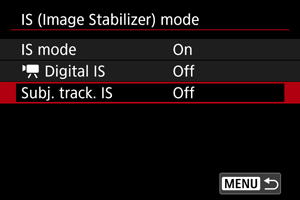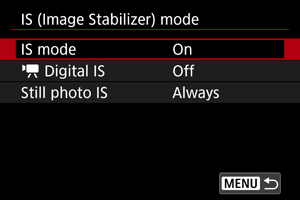Image Stabilizer (IS Mode)
Image stabilization reduces camera shake during movie recording and still photo shooting. The available features differ during movie recording and still photo shooting.
-
Select and set the item.
Movie recording

Still photo shooting

-
IS mode (movies/still photos)
Activates image stabilization using the camera's IS mode feature.
-
Movie Digital IS (movies)
Activates image stabilization using the electronic IS mode feature.
The image will be slightly magnified during IS mode when turned [On] (
).
When [Enhanced] (
) is set, it can compensate for stronger camera shaking than the [On] setting. The image will be more magnified.
Set to [Off] (
) to disable image stabilization with Movie digital IS.
-
Subject tracking IS (movies)
Set to [On] (
) to activate image stabilization that keeps subjects relatively fixed on the screen.
Tap the subject to be tracked to display a tracking frame (locked) [
] and start the Subject tracking IS.
[Screen center] activates image stabilization that keeps subjects being tracked near the center of the screen.
[Sel. position] activates image stabilization so as to keep the subject at the position when tapped.
-
Still photo IS (still photos)
Select [Always on] to provide constant image stabilization. [Only for shot]: Image stabilization is active only at the moment of shooting.
-
Caution
-
Movie Digital IS
- Stabilization by Movie digital IS may be less effective at some movie recording sizes.
- The wider the angle of view (wide angle), the more effective the image stabilization will be. The narrower the angle of view (telephoto), the less effective the image stabilization will be.
- When using a tripod, setting Movie digital IS to [Off] is recommended.
- Depending on the subject and shooting conditions, the subject may blur noticeably (the subject momentarily looks out of focus) due to the effects of the Movie digital IS.
- Since the images is magnified, the image appears more grainy. Noise, dots of light, etc. may also become noticeable.
- When the frame rate is set to 119.88 fps/100.00 fps, Movie Digital IS may not provide sufficient stabilization when shooting near the closest focusing distance.
-
Subject tracking IS
- For details about how to select the subject to be tracked, see “Tracking with a Button” () and “Subject to Detect” ().
- When the tracking target lock is canceled, lock the subject once again as the tracking target.
- The following types of subjects or shooting conditions may prevent proper subject tracking.
- Subjects with very low contrast.
- Subjects in low light.
- Strongly backlit or reflective subjects.
- There are two or more possible subjects to be tracked on screen.
- The subject to be tracked is hidden or partially hidden.
- When there are fluctuations in the subject's dimensions.
- When there are changes in the subject's color or brightness.
- When the subject frequently changes its posture.
- When the camera moves too quickly or slowly.
- When the camera movement does not match the subject's movement.
- With long lens focal lengths.
- The effect of stabilizing the subject position increases as the angle of view widens (wide‐angle side) and decreases as the angle of view narrows (telephoto side).
- Since Subject tracking IS magnifies the image, the image appears more grainy. Noise, dots of light, etc. may also become noticeable.
Note
-
When using the Subject tracking IS feature, it is recommended that you shoot while moving the camera in a smooth manner to keep the subject being tracked in the following locations.
When set to [Screen center]: near the center of the screen
When set to [Sel. position]: position when tapped